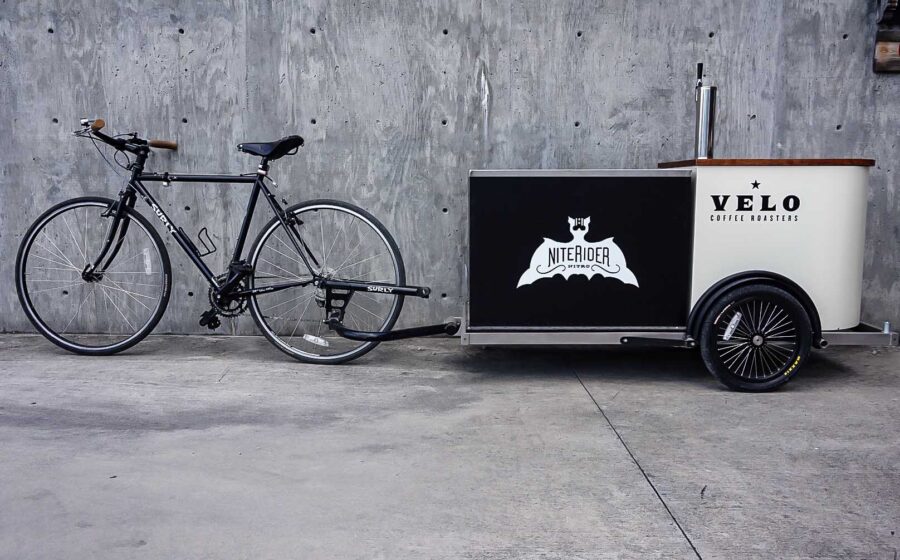[W]hen Velo Coffee Roasters in Chattanooga, Tennessee first decided to promote their Niterider Nitro cold-brew coffee by riding a “nitro bike” around town, they quickly encountered a problem: no bike-pulled carts could pump out nitrogenated cold-brew. So, they built one.
“We’d never built a cooler before, but it turns out we built a good one,” says Cody Baldwin, head of production and cold-brew at Velo. “It was simple: we built a cooler out of sheet metal we had bent, insulated it with commercial, food-grade foam, and added a stainless steel lining.” The next step was to connect the cooler with a standard stout tap, hook it up to a nitrogen tank, and fit it all in a bike trailer.
The slick black-and-white rig draws in curious passersby every week at the local farmers market and outdoor events around town. The results have been so positive that the company plans to build a similar tap setup in the back of their company car so they can hold demos outside the Chattanooga region.
“At first, everyone assumes we’re pouring beer. A lot of people are caught off guard when they find out it’s coffee but they’re usually curious and give it a try.”
Cold-brew is the cresting wave of coffee innovation and a wide-open opportunity in the market right now. Roasters all over the United States are taking the plunge into these fragrant waters, and many recognize the added value of nitrogenating the brew. Stumptown recently released canned nitro cold-brew, while roasters all over the country have been selling glasses cascading coffee for some time. Taking the leap from concept to execution is difficult when there’s an aura of secrecy surrounding necessary practices, which meant that Velo started at the drawing board, just like everyone else. Baldwin says the inspiration to experiment with nitro cold-brew came from seeing Cuvée Coffee’s and Stumptown’s versions on Instagram, and wanting to taste their products without traveling to Texas or Oregon.
“We went through a lot of trial and error,” says Baldwin. They first got to work on Niterider Nitro in December of 2014, when. Back then the company was staffed only by the two founders, Jessica and Andrew Gage, but with the rapid success of their cold-brew Velo brought on another owner and several staff members. Experimentation was ongoing: initially determined to use single-origin coffees in the cold-brew, the team eventually settled on a sixty-forty blend of a washed Colombian and a natural Ethiopian for a bright, berry-forward profile grounded in chocolate undertones. Currently, in the increasingly cramped lab and production space at Velo’s headquarters, they are brewing with four twenty-quart Filtrons with wool filters. Down the road, there is the possibility of a 500-gallon mash tun for cold-brew. This would require moving some walls but is the logical next step in meeting the demands of larger-scale production. “Right now, we are brewing sixteen-hour batches in each of the Filtrons every day,” says Baldwin.
Coffee brewed, the next step addresses the obvious question: how do you get the bubbles in? The process is simple, says Baldwin. The team settled on using Corny (or Cornelius) kegs, which are simple kegs once used by soda companies before they switched to bags of concentrate. They’re, Baldwin says, “easy to use, inexpensive, and all over the market.” The coffee is diluted to drinking strength, then chilled for twenty-four hours in a rented walk-in refrigerator until it is below forty degrees. Once chilled, the coffee is infused with nitrogen. This, says Baldwin, is the tricky part. “You have to shake the kegs vigorously for about eight minutes while infusing the nitrogen, and at first, we were manually doing it! We’d get in a weightlifting stance and shake the kegs over our heads. But there was no way to scale this, so we invented a keg shaker that lets us strap in the keg, hook the nitrogen up to about forty PSI, and shake as long as we need.”
Currently Velo has six accounts serving Niterider, and big plans for expansion. When a new account comes on board, Velo provides all the equipment for the tap and sets it up for them, only requiring a line completely dedicated to the coffee. When it comes to dispensing the brew, Baldwin stresses the need to use a “stout faucet,” commonly used to serve Guinness. “There is a small disk with tiny holes, kind of like a portafilter,” he says, “and when you push it through with the nitrogen, it restricts the flow and results in that creamy, blond-colored stream, which starts cascading in the glass.” It’s necessary to keep the cold-brew below forty degrees and thirty PSI in order to preserve the bubbles.
Nitrogenated coffee is still new to many coffee drinkers, and seeing it poured from the back of a bike can cause a double-take. “At first, everyone assumes we’re pouring beer,” Baldwin says. “A lot of people are caught off guard when they find out it’s coffee but they’re usually curious and give it a try. Most people seem to really be into it! “
Cold-brew, for Velo, seems to be the ticket to healthy expansion, for which the owners have laid the groundwork with diligence. Recently the company Kickstarter-funded a new Joper fifteen-kilo roaster, and has grown strong support among the community of Chattanooga. With stylish branding and now-seamless execution of Niterider, that region is just the beginning.
—Emily McIntyre is a regular contributor to Fresh Cup, and the co-owner of Catalyst Coffee Consulting.

















